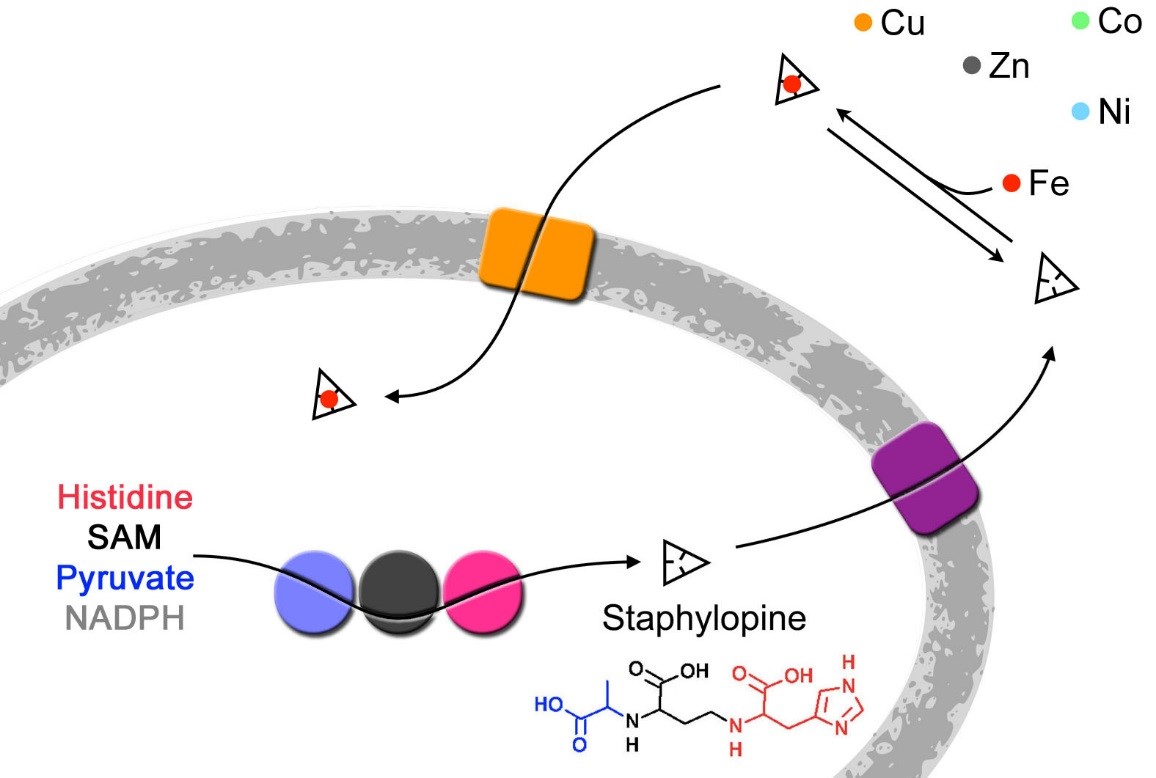The so-called biologic metals are necessary for life. Pathogenic bacteria have developed elaborate systems to compensate for the low concentration of these essential metals in their environment, in particular within a host. The case of iron is particularly well documented with, in some bacteria, the production of molecules called siderophores that specifically capture iron in the medium. Researchers have now identified a new metal scavenging molecule produced in the bacterium Staphylococcus aureus and baptized it staphylopine.
The researchers from CEA, CNRS and Aix-Marseille Université, at Cadarache (Bouches-du-Rhône, France) and from INRA , in collaboration with Université de Pau (Pyrénées-Atlantiques, France), and the Umeå University in Sweden, highlighted the role of the key players that allow the pathogen to acquire a wide range of essential metals in the environment, such as nickel, zinc, cobalt, copper and iron (Figure 1). Three enzymes, whose functions were unknown so far, allow the production of staphylopine by the combination of three building blocks (D-histidine, amino butyrate and pyruvate). An export system allows the staphylopine to get out of the cell in order to trap the target metals from the extracellular medium. The staphylopine / metal duo can then be picked up by the cell via a specific import system (Figure 1). In the absence of these import / export systems, the virulence of Staphylococcus aureus was known to be reduced, although the origins of this phenomenon were not fully understood. The knowledge of how staphylopine is made and its transport modes could therefore open the way for a new strategy in the fight against pathogenic bacteria, targeting their dependence to metals.
Surprisingly, staphylopine closely resembles nicotianamine, a molecule that is found in all plants and that ensures the transport of essential metals from the roots, where they are collected, to the various aerial organs. The discovery of a similar metal scavenger in the three kingdoms of life (archaea, eukaryotes and now bacteria) suggests an ancient origin for this type of molecule.

Figure 1: Model of staphylopine function, involving three biosynthetic enzymes (blue, gray and fuchsia) that use common precursors, one exporter (magenta), and an importer belonging to the family of ABC transporters (simplified here in orange). © DR
1 From UMR 7265 CEA-CNRS-Aix-Marseille Université : Biam (CEA/’Institut de biosciences et biotechnologies d’Aix-Marseille’) ; BVME (Aix-Marseille Université et CNRS/’Biologie végétale et microbiologie environnementales’).2 Also in collaboration with a scientist of ‘Laboratoire d'ingénierie des systèmes macromoléculaires’ (CNRS/AMU) located in Marseille.
3 Micalis : ‘Institut de microbiologie au service de la santé’, UMR1319 Inra research centre, Jouy-en-Josas.
4 Belonging to ’Institut des sciences analytiques et de physico-chimie pour l’environnement et les matériaux’ (CNRS/UPPA).